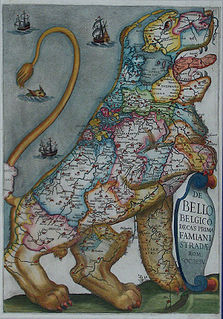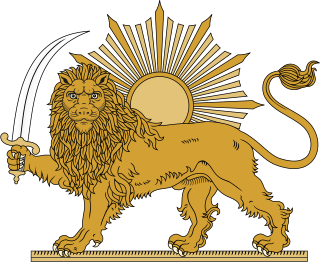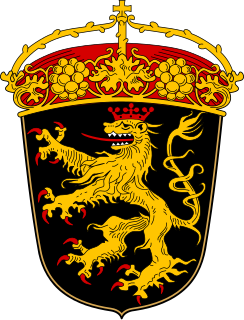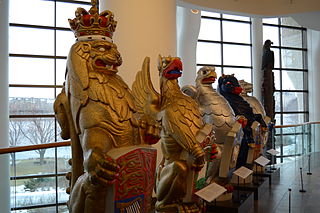 W
WThe lion is a common charge in heraldry. It traditionally symbolises courage, nobility, royalty, strength, stateliness and valour, because historically the lion has been regarded as the "king of beasts". The lion also carries Judeo-Christian symbolism. The Lion of Judah stands in the coat of arms of Jerusalem. Similar-looking lions can be found elsewhere, such as in the coat of arms of the Swedish royal House of Bjelbo, from there in turn derived into the coat of arms of Finland, formerly belonging to Sweden.
 W
WThe Brunswick Lion is a monument and the best-known landmark in the German city of Braunschweig (Brunswick). It is located on the Burgplatz square in front of Dankwarderode Castle and Brunswick Cathedral. Within Brunswick, it is commonly known as the "Castle Lion" (Burglöwe).
 W
WThe Dutch Republic Lion was the badge of the Union of Utrecht, the Republic of the Seven United Netherlands and is a precursor of the current coat of arms of the Kingdom the Netherlands.
 W
WThe Lion of Judah is a Jewish national and cultural symbol, traditionally regarded as the symbol of the Israelite tribe of Judah. According to the Torah, the tribe consists of the descendants of Judah, the fourth son of Jacob. The association between Judah and the lion can first be found in the blessing given by Jacob to his son Judah in the Book of Genesis.
 W
WThe Leo Belgicus was used in both heraldry and map design to symbolize the former Low Countries with the shape of a lion.
 W
WThe Lion and Sun is one of the main emblems of Iran (Persia), and formerly was an element in Iran's national flag until the 1979 Iranian Revolution. The motif, which illustrates ancient and modern Iranian traditions, became a popular symbol in Iran in the 12th century. The lion and sun symbol is based largely on astronomical and astrological configurations: the ancient sign of the sun in the house of Leo, which itself is traced back to Babylonian astrology and Near Eastern traditions.
 W
W"The lamb with the lion" – often a paraphrase from Isaiah, and more closely quoted as "the lion and lamb", "a child will lead them", and the like – are an artistic and symbolic device, most generally related to peace.
 W
WThe Lion and the Unicorn are symbols of the United Kingdom. They are, properly speaking, heraldic supporters appearing in the full royal coat of arms of the United Kingdom. The lion stands for England and the unicorn for Scotland. The combination therefore dates back to the 1603 accession of James I of England who was already James VI of Scotland. By extension, they have also been used in the arms of Hanover between 1837–1866 and the arms of Canada since 1921.
 W
WThe Lion of Babylon is an ancient Babylonian symbol.
 W
WThe Lion of Saint Mark, representing Mark the Evangelist, pictured in the form of a winged lion, is an aspect of the Tetramorph. On the pinnacle of St Mark's Cathedral he is depicted as holding a Bible, and surmounting a golden lion which is the symbol of the city of Venice and formerly of the Venetian Republic.
 W
WThe Macedonian lion is an unofficial symbol of North Macedonia. After the independence of the Republic of Macedonia from Yugoslavia, the lion was proposed as a coat of arms of the new independent state several times.
 W
WThe Marzocco is the heraldic lion that is a symbol of Florence, and was apparently the first piece of public secular sculpture commissioned by the Republic of Florence, in the late 14th century. It stood at the heart of the city in the Piazza della Signoria at the end of the platform attached to the Palazzo Vecchio called the ringhiera, from which speakers traditionally harangued the crowd. This is now lost, having weathered with time to an unrecognizable mass of stone.
 W
WThe Merlion is the national symbol of the city-state of Singapore. It is depicted as a mythical creature with a lion's head and the body of a fish. Being of prominent symbolic nature to Singapore and Singaporeans in general, it is widely used to represent both the country and its people in sports teams, advertising, branding, tourism and as a national personification and patriotic emblem of the Singaporean nation.
 W
WThe Palatine Lion, less commonly the Palatinate Lion, is an heraldic charge. It was originally part of the family coat of arms of the House of Wittelsbach and is found today on many coats of arms of municipalities, counties and regions in South Germany and the Austrian Innviertel.
 W
WThe Queen's Beasts are ten heraldic statues representing the genealogy of Queen Elizabeth II, depicted as the Royal supporters of England. They stood in front of the temporary western annexe to Westminster Abbey for the Queen's coronation in 1953. Each of The Queen's Beasts consists of an heraldic beast supporting a shield bearing a badge or arms of a family associated with the ancestry of Queen Elizabeth II. They were commissioned by the British Ministry of Works from the sculptor James Woodford, who was paid the sum of £2,750 for the work. They were uncoloured except for their shields at the coronation. They are now on display in the Canadian Museum of History in Quebec.
 W
WIn heraldry, the term sea-lion refers to a legendary creature that has the head and upper body of a lion, but with webbed forelimbs and a fish tail. These occur most frequently as supporters, but also occur as crests and occasionally as charges. Sea-lions are frequently found in "sejant" or "sejant-erect" attitudes, but may also be found "naiant" or "assurgeant".
 W
WThe Snow Lion, sometimes also Snowlion, is a celestial animal of Tibet. It is the emblem of Tibet, representing the snowy mountain ranges and glaciers of Tibet, and may also symbolize power and strength, and fearlessness and joy, east and the earth element. It is one of the Four Dignities. It ranges over the mountains, and is commonly pictured as being white with a turquoise mane. In Journey to the West published in 1592, Snow Lion is depicted as one of Yōkais .
 W
WThe Veldenz lion is a heraldic emblem. As a charge the heraldic lion in the coat of arms has a stationary appearance. The blazon is "argent, a lion rampant azure, armed and langued gules".
 W
WThe winged lion is a mythological creature that resembles a lion with bird-like wings.